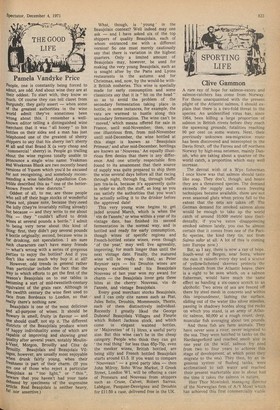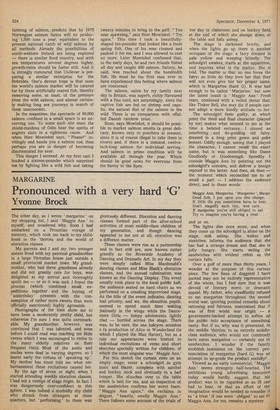SPORTING LIFE
Clive Gammon
A rare ray of hope for salmon-eaters and salmon-catchers has come from Norway. For those unacquainted with the present plight of the Atlantic salmon, I should explain that there is a two-fold threat to the species. An unidentified virus has, since 1964, been killing a large proportion of salmon in British rivers before they reach the spawning grounds, fatalities reaching 90 per cent on some waters. Next, their previously unknown sea-migration route has been discovered and intercepted in the Davis Strait, off the Faroes and off northern Norway by high-seas netsmen, mainly Danish, who are taking about a quarter of the world catch, a proportion which may well increase.
The devout wish of a Wye fisherman I once knew was that salmon should taste like soap. They don't, though, and hence they are a threatened species. The demand exceeds the supply and since freezing techniques became available, there are not even seasonal gluts when prices fall to the extent that the nets are taken off. The German demand for smoked salmon alone would be enough to take up the world catch of around 10,000 metric tons (incidentally, if you've eaten disappointing smoked salmon lately, you can be almost certain that it comes from one of the Pacific species, the kind they tin, not from Salmo salar at all. A lot of this is coming into Europe now.) But, as I say, there is now a ray of hope. South-west of Bergen, near Sotra, where the rain it raineth every day and a scatter of yellow-lichened skerries protects the fiord-mouth from the Atlantic heave, there is a sight to be seen which, on a salmon fisherman, would have much the same effect as handing a six-ounce scotch to an alcoholic. Two acres of sea are fenced off there by steel mesh in concrete and within this impoundment, lashing the surface. sliding out of the water like silver missiles. passing in shadowy hordes along the rocks on which you stand, is an army of Atlantic salmon, 80,000 at a rough count, deep, muscular fish averaging about ten pounds.
And these fish are farm animals. They have never seen a river, never migrated to the sea. They were hatched in tanks on the Hardangerfiord and reached smolt size in one year (in the wild, salmon fry need from two to four years to achieve this stage of development, at which point they migrate to the sea). They then, by an ingenious system of flushed tanks, were acclimatised to salt water and reached their present marketable size in about half the time it takes the salmon in nature.
Herr Thor Mowinkel, managing director of the Norwegian firm of A/S Mowi which has achieved this first commercially viable farming of salmon, predicts that by 1975 Norwegian salmon farms will be producing 1,500 tons a year, equivalent to the present national catch of wild salmon by all methods. Already the possibilities of south-western Ireland are being explored — there is similar fiord country, and with sea temperatures several degrees higher, growth-rates should be faster still. And it is strongly rumoured that Unilever is preparing a similar enterprise for the Hebrides. One's devout hope is that soon the world's salmon market will be catered for by these artificially reared fish, thereby removing some, at least, of the pressure from the wild salmon, and almost certainly making long sea journeys in search of them uneconomic.
In the meantime, the spectacle of 80,000 salmon confined in a small space is an unnerving one. To some such site must the shield-maidens of Odin bear the spirits of anglers slain in a righteous cause. And when Herr Mowinkel says, "Please!" invitingly and hands you a salmon rod, then perhaps you are in danger of becoming disorientated for ever.
This danger I scorned. At my first cast I hooked a sixteen-pounder which surprised me by fighting like a wild fish and taking twenty minutes to bring to the gaff. "Too near spawning," said Herr Mowinkel. "Try again." This time I took a beautifullyshaped ten-pounder that looked like a fresh spring fish. One of his men cleaned and packed it for me, and I was allowed to cast no more. Later Mowinkel confessed that, in the early days, he and two friends fished all day and caught 400 salmon. Satiety, he said, was reached about the hundredth fish. He must be the first man ever to have experienced this feeling where salmon are concerned.
The salmon, eaten by my family next day in Britain, was superb, richly flavoured with a fine curd, not surprisingly, since the captive fish are fed on shrimp and capeFin, the natural diet of the salmon in the wild There is no comparison with offalfed Danish rainbow trout.
Soon, says Mowinkel, it should be possible to market salmon smolts (a great delicacy, known only to poachers at present, since it is of course illegal to take them in rivers) and, if there is a demand, twelveinch-long salmon for individual serving. And salmon in prime condition will be available all through the year. Which should be good news for everyone from the Savoy to the Spey.











































 Previous page
Previous page